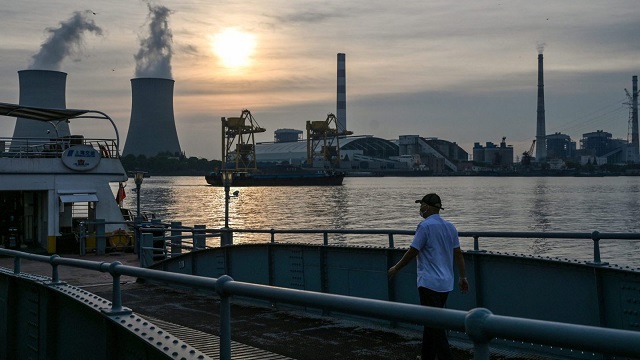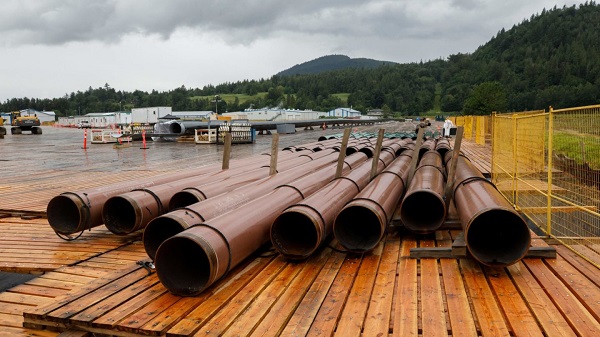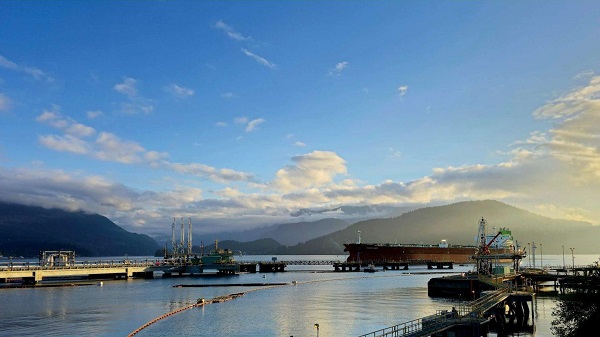Canadian Energy Centre
Reality check: Global emissions from coal plants

A man walks towards a ferry as the Wujing coal-electricity power station is seen across the Huangpu River in the Minhang district of Shanghai. Getty Images photo
From the Canadian Energy Centre
Coal remains the primary fuel for global electricity generation, particularly in Asian countries
High energy prices, inflation, war, and the ongoing economic recovery from the pandemic has highlighted the general worldwide demand for electricity, particularly in Asia and Europe. The growing demand for electricity on these two continents has led some electricity producing plants to rely increasingly heavily on coal as a power source.
The electricity sector accounts for 34 per cent of the world’s energy-related carbon dioxide (CO2) emissions. In this Fact Sheet, we detail recent trends in electricity production and demand across the globe as well as CO2 emissions from the electricity sector worldwide.
Carbon dioxide emissions from the world’s top ten emitters between 2000 and 2022
A total of 38.2 gigatonnes (Gt) of energy-related CO2 was emitted globally in 2022, an increase of 53 per cent from 2000. However, the increase is not consistent for all countries; between 2000 and 2023, CO2 emissions trends diverged. Emissions from China, India, and Indonesia more than doubled in the last two decades, whereas emissions for other countries remained relatively consistent or even declined.
In 2022, Canada’s total energy-related CO2 emissions were 0.62 Gt, or 1.6 per cent of the global total. That compares to emissions of 0.64 Gt in South Korea, 1.09 Gt in Japan, 2.8 Gt in India, 5.0 Gt in the United States, and 13.0 Gt in China (see Figure 1).

Sources: IEA World Energy Statistics database and Enerdata
Demand for electricity and sources of emissions
Global domestic electricity consumption increased from 13,188 terawatt-hours (TWh) in 2000 to 25,681 TWh in 2022 and estimates are that global demand for electricity will rise to 35,000 TWh by 2040.¹
That is a jump of 94 per cent, or 12,492 TWh, between 2000 and 2022. During the same period, electricity consumption in Asia rose a whopping 280 per cent. In Africa the demand for electricity increased by 90 per cent (see Figure 2). Coal remains the world’s largest source of fuel for electricity generation, with approximately 10,317 terawatt-hours of electricity generated by coal-fired plants in 2022 (see Figure 3).
1. The IEA’s Electricity Market Report 2022 states that nearly all of the increase is attributable to growing electricity consumption in developing countries across southeast Asia and Africa.

Sources: IEA World Energy Statistics database and Enerdata

Sources: IEA World Energy Statistics database and Enerdata
In recent years, electricity generated from the combustion of coal declined in Canada, the United States, Europe, and Africa. However, electricity generated from coal combustion has continued to grow in China, India, and other parts of Asia.
Between 2000 and 2022, the share of coal-powered electricity generation in Asia increased from 49.8 to 56. 3 per cent, while in Canada it decreased from 19.4 per cent to less than 5 per cent.

Sources: IEA World Energy Statistics database and Enerdata
Source of emissions in the electricity sector
The electricity sector accounts for 34 per cent of the carbon dioxide emitted across the world. The sector emitted 13.05 gigatonnes of CO2 in 2022, an increase of 5.01 Gt from 2000. In Asia, between 2000 and 2022, CO2 emissions from the electricity sector increased from 2.5 Gt to 8.3 Gt and the sector’s share of carbon dioxide (CO2) emissions increased from just over 32 per cent to well over 40 per cent (see Figure 5).

Sources: IEA World Energy Statistics database and Enerdata
Coal burned to generate electricity accounts for the majority of the CO2 emitted in power generation. In 2022, coal-fired electricity\ generation accounted for 9.89 Gt, or nearly 76 per cent of the worldwide CO2 emissions from the electricity sector. The share was even higher in Asia where 92 per cent of emissions from the electricity sector come from coal combustion. Asian coal-fired plants accounted for 7.62 Gt of the total 8.26 Gt of emissions from the sector on that continent (see Figure 6).

Sources: IEA World Energy Statistics database and Enerdata
Conclusion
The global electricity sector, and particularly the sector in Asia, is a major source of CO2 emissions. Relative to Canada’s existing carbon emissions, emissions from the coal-fired power plants worldwide will make any reductions in Canada’s carbon emissions and resulting job losses, higher taxes, and higher costs for consumers and businesses—meaningless.
As 56 per cent of the electricity in Asia is generated by coal-fired plants, a transition from coal- to gas-fired electricity generation in the region could lead to significant reductions in CO2 emissions, reducing emissions by 50 per cent on average. The corollary is that there is a potential market in Asia for natural gas extracted in and exported from Canada. Canada has an opportunity to play a useful and meaningful role in reducing CO2 emissions from the electricity sector by encouraging and contributing to the global natural gas market.
Notes
This CEC Fact Sheet was compiled by Ven Venkatachalam at the Canadian Energy Centre (www.canadianenergycentre.ca). The author and the Canadian Energy Centre would like to thank and acknowledge the assistance of an anonymous reviewer in reviewing the data and research for this Fact Sheet.
References (live as of November 2, 2023)
Canadian Energy Centre (November 7, 2022), Canadian LNG has massive opportunity in Asia: report <https://tinyurl.com/2p9525j6>; Enerdata (2022), Power Plant Tracker database <https://bit.ly/3xfgOdF>; IEA (2022), Electricity Market Report – January 2022 <https://bit.ly/3M0723j> IEA (Undated), World Energy Statistics Database <https://tinyurl.com/ytz789m4>
Alberta
The case for expanding Canada’s energy exports

From the Canadian Energy Centre
For Canada, the path to a stronger economy — and stronger global influence — runs through energy.
That’s the view of David Detomasi, a professor at the Smith School of Business at Queen’s University.
Detomasi, author of Profits and Power: Navigating the Politics and Geopolitics of Oil, argues that there is a moral case for developing Canada’s energy, both for Canadians and the world.
CEC: What does being an energy superpower mean to you?
DD: It means Canada is strong enough to affect the system as a whole by its choices.
There is something really valuable about Canada’s — and Alberta’s — way of producing carbon energy that goes beyond just the monetary rewards.
CEC: You talk about the moral case for developing Canada’s energy. What do you mean?
DD: I think the default assumption in public rhetoric is that the environmental movement is the only voice speaking for the moral betterment of the world. That needs to be challenged.
That public rhetoric is that the act of cultivating a powerful, effective economic engine is somehow wrong or bad, and that efforts to create wealth are somehow morally tainted.
I think that’s dead wrong. Economic growth is morally good, and we should foster it.
Economic growth generates money, and you can’t do anything you want to do in social expenditures without that engine.
Economic growth is critical to doing all the other things we want to do as Canadians, like having a publicly funded health care system or providing transfer payments to less well-off provinces.
Over the last 10 years, many people in Canada came to equate moral leadership with getting off of oil and gas as quickly as possible. I think that is a mistake, and far too narrow.
Instead, I think moral leadership means you play that game, you play it well, and you do it in our interest, in the Canadian way.
We need a solid base of economic prosperity in this country first, and then we can help others.
CEC: Why is it important to expand Canada’s energy trade?
DD: Canada is, and has always been, a trading nation, because we’ve got a lot of geography and not that many people.
If we don’t trade what we have with the outside world, we aren’t going to be able to develop economically, because we don’t have the internal size and capacity.
Historically, most of that trade has been with the United States. Geography and history mean it will always be our primary trade partner.
But the United States clearly can be an unreliable partner. Free and open trade matters more to Canada than it does to the U.S. Indeed, a big chunk of the American people is skeptical of participating in a global trading system.
As the United States perhaps withdraws from the international trading and investment system, there’s room for Canada to reinforce it in places where we can use our resource advantages to build new, stronger relationships.
One of these is Europe, which still imports a lot of gas. We can also build positive relationships with the enormous emerging markets of China and India, both of whom want and will need enormous supplies of energy for many decades.
I would like to be able to offer partners the alternative option of buying Canadian energy so that they are less reliant on, say, Iranian or Russian energy.
Canada can also maybe eventually help the two billion people in the world currently without energy access.
CEC: What benefits could Canadians gain by becoming an energy superpower?
DD: The first and primary responsibility of our federal government is to look after Canada. At the end of the day, the goal is to improve Canada’s welfare and enhance its sovereignty.
More carbon energy development helps Canada. We have massive debt, an investment crisis and productivity problems that we’ve been talking about forever. Economic and job growth are weak.
Solving these will require profitable and productive industries. We don’t have so many economic strengths in this country that we can voluntarily ignore or constrain one of our biggest industries.
The economic benefits pay for things that make you stronger as a country.
They make you more resilient on the social welfare front and make increasing defence expenditures, which we sorely need, more affordable. It allows us to manage the debt that we’re running up, and supports deals for Canada’s Indigenous peoples.
CEC: Are there specific projects that you advocate for to make Canada an energy superpower?
DD: Canada’s energy needs egress, and getting it out to places other than the United States. That means more transport and port facilities to Canada’s coasts.
We also need domestic energy transport networks. People don’t know this, but a big chunk of Ontario’s oil supply runs through Michigan, posing a latent security risk to Ontario’s energy security.
We need to change the perception that pipelines are evil. There’s a spiderweb of them across the globe, and more are being built.
Building pipelines here, with Canadian technology and know-how, builds our competitiveness and enhances our sovereignty.
Economic growth enhances sovereignty and provides the resources to do other things. We should applaud and encourage it, and the carbon energy sector can lead the way.
Business
Oil tanker traffic surges but spills stay at zero after Trans Mountain Expansion

From the Canadian Energy Centre
Bigger project maintains decades-long marine safety record
The Trans Mountain system continues its decades-long record of zero marine spills, even as oil tanker traffic has surged more than 800 per cent since the pipeline’s expansion in May 2024.
The number of tankers calling at Trans Mountain’s Westridge Marine Terminal in the Port of Vancouver in one month now rivals the number that used to go through in one year.
A global trend toward safer tanker operations
Trans Mountain’s safe operations are part of a worldwide trend. Global oil tanker traffic is up, yet spills are down, according to the International Tanker Owners Pollution Federation, a London, UK-based nonprofit that provides data and response support.
Transport Canada reports a 95 per cent drop in ship-source oil spills and spill volumes since the 1970s, driven by stronger ship design, improved response and better regulations.
“Tankers are now designed much more safely. They are double-hulled and compartmentalized to mitigate spills,” said Mike Lowry, spokesperson for the Western Canada Marine Response Corporation (WCMRC).
WCMRC: Ready to protect the West Coast

One of WCMRC’s new response vessels arrives in Barkley Sound. Photo courtesy Western Canada Marine Response Corporation
From eight marine bases including Vancouver and Prince Rupert, WCMRC stands at the ready to protect all 27,000 kilometres of Canada’s western coastline.
Lowry sees the corporation as similar to firefighters — training to respond to an event they hope they never have to see.
In September, it conducted a large-scale training exercise for a worst-case spill scenario. This included the KJ Gardner — Canada’s largest spill response vessel and a part of WCMRC’s fleet since 2024.
“It’s part of the work we do to make sure everybody is trained and prepared to use our assets just in case,” Lowry said.
Expanding capacity for Trans Mountain

The K.J. Gardner is the largest-ever spill response vessel in Canada. Photo courtesy Western Canada Marine Response Corporation
WCMRC’s fleet and capabilities were doubled with a $170-million expansion to support the Trans Mountain project.
Between 2012 and 2024, the company grew from 13 people and $12 million in assets to more than 200 people and $213 million in assets.
“About 80 per cent of our employees are mariners who work as deckhands, captains and marine engineers on our vessels,” Lowry said.
“Most of the incidents we respond to are small marine diesel spills — the last one was a fuel leak from a forest logging vessel near Nanaimo — so we have deployed our fleet in other ways.”
Tanker safety starts with strong rules and local expertise

Tanker loading at the Westridge Marine Terminal in the Port of Vancouver. Photo courtesy Trans Mountain Corporation
Speaking on the ARC Energy Ideas podcast, Trans Mountain CEO Mark Maki said tanker safety starts with strong regulations, including the use of local pilots to guide vessels into the harbour.
“On the Mississippi River, you have Mississippi River pilots because they know how the river behaves. Same thing would apply here in Vancouver Harbour. Tides are strong, so people who are familiar with the harbor and have years and decades of experience are making sure the ships go in and out safely,” Maki said.
“A high standard is applied to any ship that calls, and our facility has to meet very strict requirements. And we have rejected ships, just said, ‘Nope, that one doesn’t fit the bill.’ A ship calling on our facilities is very, very carefully looked at.”
Working with communities to protect sensitive areas
Beyond escorting ships and preparing for spills, WCMRC partners with coastal communities to map sensitive areas that need rapid protection including salmon streams, clam beds and culturally important sites like burial grounds.
“We want to empower communities and nations to be more prepared and involved,” Lowry said.
“They can help us identify and protect the areas that they value or view as sensitive by working with our mapping people to identify those areas in advance. If we know where those are ahead of time, we can develop a protection strategy for them.”
-

 Bruce Dowbiggin1 day ago
Bruce Dowbiggin1 day agoWayne Gretzky’s Terrible, Awful Week.. And Soccer/ Football.
-

 espionage23 hours ago
espionage23 hours agoWestern Campuses Help Build China’s Digital Dragnet With U.S. Tax Funds, Study Warns
-

 Focal Points14 hours ago
Focal Points14 hours agoCommon Vaccines Linked to 38-50% Increased Risk of Dementia and Alzheimer’s
-

 Opinion1 day ago
Opinion1 day agoThe day the ‘King of rock ‘n’ roll saved the Arizona memorial
-

 Automotive4 hours ago
Automotive4 hours agoThe $50 Billion Question: EVs Never Delivered What Ottawa Promised
-

 Agriculture1 day ago
Agriculture1 day agoCanada’s air quality among the best in the world
-

 Business21 hours ago
Business21 hours agoCanada invests $34 million in Chinese drones now considered to be ‘high security risks’
-

 Health12 hours ago
Health12 hours agoThe Data That Doesn’t Exist






